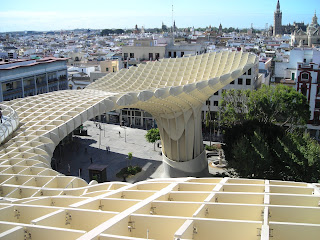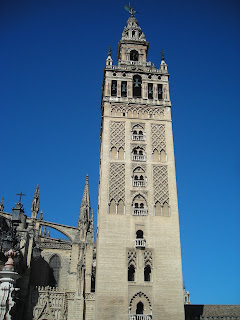There were so many interesting places in this town it was hard to get to them all. I will have to go back and continue to enjoy the sites. A landmark is the new birds nest looking structure with old Roman ruins preserved underneath. You can go up to the top of the structure and see much of the town.
There are restaurants on the upper level and I had an awesome chocolate covered churro on the middle level.
We climbed the bell tower and the sites from there were also great. It was a long hike up and the bells on the top were numerous. There is a clock built hundreds of years ago that is still working.
There is a beautiful building and park built I think in the 20s for a world exposition. You can rent a boat and row around the complex. On the inner courtyard there is seating with a tile map of each region in Spain.
The flowers around town were vibrant.
The bull ring is suppose to be one of the best in Spain. Posters from past seasons covered the walls in one section. Statues of big name fighters a located around the complex. I rode a wild horse, lucky to get off with out killing myself.
The outside artwork is everywhere.
Went to a couple museums. One has the largest collection of Spanish artists.
Of course no trip to Seville would be complete without a trip to the Flamenco Bars. The gypsy section over the river in Triana is suppose to get wild at night. we went to a very cool Flamenco Bar that opens at 11:00. It is hard to find, look for the red doors, but the place was jammed.
I could put 100 more pictures of the trip and talk about what I saw for hours, but you will have to wait till you see me for the full report. Enjoy.
There are restaurants on the upper level and I had an awesome chocolate covered churro on the middle level.
We climbed the bell tower and the sites from there were also great. It was a long hike up and the bells on the top were numerous. There is a clock built hundreds of years ago that is still working.
There is a beautiful building and park built I think in the 20s for a world exposition. You can rent a boat and row around the complex. On the inner courtyard there is seating with a tile map of each region in Spain.
The flowers around town were vibrant.
The bull ring is suppose to be one of the best in Spain. Posters from past seasons covered the walls in one section. Statues of big name fighters a located around the complex. I rode a wild horse, lucky to get off with out killing myself.
The outside artwork is everywhere.
Went to a couple museums. One has the largest collection of Spanish artists.
Of course no trip to Seville would be complete without a trip to the Flamenco Bars. The gypsy section over the river in Triana is suppose to get wild at night. we went to a very cool Flamenco Bar that opens at 11:00. It is hard to find, look for the red doors, but the place was jammed.
I could put 100 more pictures of the trip and talk about what I saw for hours, but you will have to wait till you see me for the full report. Enjoy.








































































